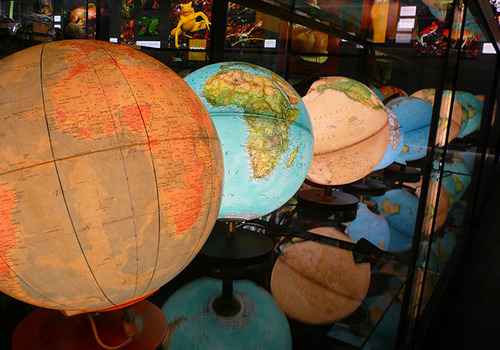6 Tips for Worldbuilding on a Time Crunch

Every story needs a setting, but crafting a world can take time that some of us (through no fault of our own, I’m sure) just don’t have. In this post, Municipal Liaison Rebekah Loper walks you through a worldbuilding word sprint!
If there’s one thing my local Wrimos know about me, it’s that I love worldbuilding. I’m not talking about just enjoying it, but it’s one of my hobbies, even when I’m not actively worldbuilding for a specific story. But it’s not that captivating for everyone.One aspect of writing often overlooked is that the story setting is just as important as your characters. You might even say that the setting is a character in its own right, but especially so if your stories are set in fictional worlds.While worldbuilding can be daunting, there are some tricks to help you determine which elements of worldbuilding are most important to develop for your story, and these will even apply if you’re a pantser who doesn’t know much about your plot yet.
So go grab a notebook (or open up a document!) and let’s get started.
1. Set a timer.This is the same concept behind word sprints. If you give yourself a set time limit, you can focus right on the task at hand. Start with 10 minutes per task below, but feel free to extend that time if you find you can focus longer. Feel free to start the timer over if you need more time to finish a section, but try not to spend more than 30 minutes total before moving on to the next one.
2. Start with your main character.This will help with any outlining you’re doing as well – who is your main character, what do they want, and why? What is important to them? What was the happiest moment of their life and/or the worst? Most importantly, how do they view themselves within their world.
3. Now that you know a little about your character, take a look at their cultural influences.This is equally as important as your character’s internal view of themselves, because outside influences often shape those views. It’s possible to break free of them in certain situations, but most of the time they will always remain a fundamental part of who they are, whether it affects them in positive or negative ways.
What were their surroundings like growing up? What are their favorite holidays? Did they have a coming of age ceremony or ritual to complete? Were they able to do so? What societal expectations weigh on their shoulders, whether those expectations are based on gender roles, vocation, or socioeconomic status? What if they are not able to accomplish any or some of those goals?
4. What does the world look like through your character’s eyes?Now that you’ve met your character and know some about their internal values and external influences, start taking a look at the world around them. Use the holidays, coming of age, and societal expectations that you may have explored in the previous task and branch off to explore more of the surrounding world. How have those things shaped not just your character, but the culture and society around them?
Additionally, what does their home look like? Their village, city, country? Desert, mountains, forest, coast, prairie?
As time allows, keep exploring your world as you expand its horizons. Look for the why behind a society’s actions, including access to natural resources (water, arable land, hunting grounds, etc.).
5. Now that you’ve explored your story setting and your character’s worldview, what potential for story conflict exists within your fictional world?Conflict is what makes your story interesting. As I said earlier, your setting is just as much a character as, well, your characters. It should enrich your story and raise the stakes. Those societal expectations you’ve started to explore may clash with the expectations of differing societies and cultures, for one. Conflict is always a potential when a character goes from one culture to another. Or, conversely, they may find they fit in better in another culture, and that can generate internal conflict!
6. The rest is just aesthetics!Seriously! While you do need to have some intentions behind why buildings, clothing, and even species might look certain ways (due to the natural resources and environment), it’s pretty much just frosting on the cake once you know the why of a society and culture. I recommend using Pinterest to collect any images that catch your interest, especially ones you just stumble on and it resonates with your world.
Any questions about worldbuilding? Just ask in the comments, and I’ll answer as soon as I can!
Also, you can sign up for my newsletter any time in September or October and get my Character Creation Chart for free!
Want to go even more in-depth with your worldbuilding? Find out more about my book, The A-Zs of Worldbuilding: Building a Fictional World From Scratch!

Rebekah Loper began creating fictional worlds and epic stories as a child and never stopped. Now she also helps inspire others to write their stories through her volunteer work as a NaNoWriMo Municipal Liaison, and with her workbook, The A-Zs of Worldbuilding: Building a Fictional World From Scratch. Her most recent release, a fantasy short story titled The Path of Mercy, is available in Beatitudes & Woes: A Speculative Fiction Anthology.
Rebekah lives in Tulsa, Oklahoma with her husband, a dog, two formerly feral cats, a flock of chickens, and an extensive tea collection. She is often found battling the elements in an effort to create a productive, permaculture urban homestead on a shoestring budget.
She blogs about writing and urban homesteading at rebekahloper.com, and has been a contributing writer for Fantasy-Faction.com. You can follow her on Facebook, Instagram, and Twitter.
Top image licensed under Creative Commons from ricardo on Flickr.
Chris Baty's Blog
- Chris Baty's profile
- 63 followers



